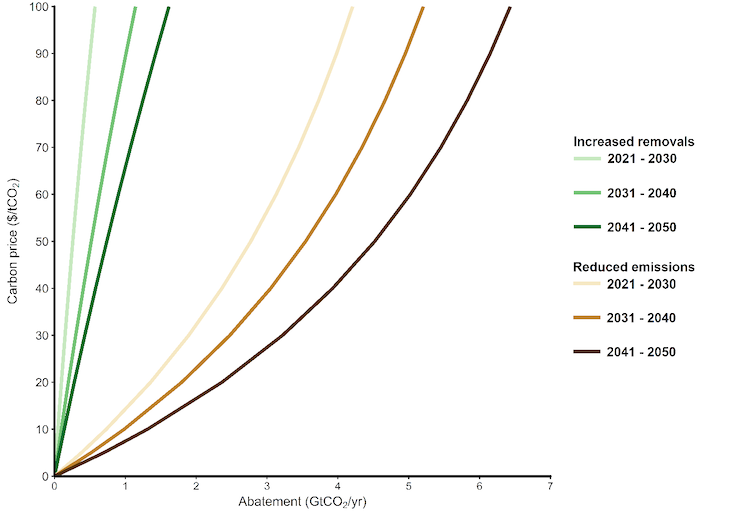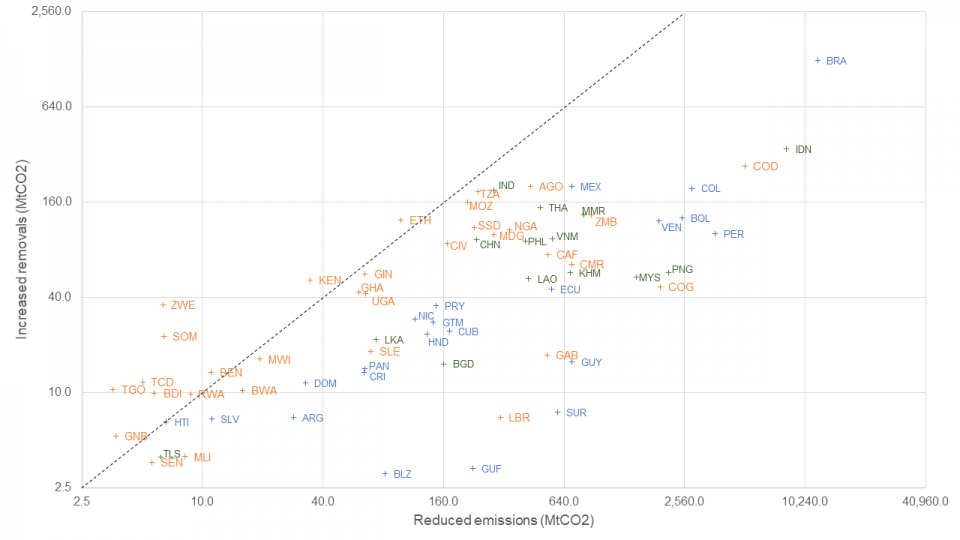Reforestation can help reverse the climate and extinction crises. It’s cost-effective too.
Reforestation can help reverse not one but two planetary crises. Reforestation offers one of the best ways to remove carbon dioxide from the atmosphere, turning it into solid carbon through photosynthesis and storing it in tree trunks, branches, roots, and soil. And reforestation can also start to rewind the habitat loss that threatens the extinction of up to 1 million plant and animal species—one-quarter of life on Earth, according to a recent United Nations report on biodiversity and ecosystem services.
Now a new study shows that reforestation can be cost-effective as a climate solution, too. Tropical reforestation can remove as much or more carbon dioxide from the atmosphere at a lower cost than many other “negative emissions technologies” (NETs) that might become available in the future. Tropical reforestation, together with avoided tropical deforestation, could comprise as much as one-third of a comprehensive and cost-effective near-term solution to climate change. These are the findings of a new study in Nature Climate Change of the cost of reforestation across 90 tropical countries that I conducted with colleagues at The Nature Conservancy and the University of Wisconsin.
Based on these findings, tropical countries should accelerate reforestation, and developed countries should step up international finance for reforestation, especially through provisions of the Paris Climate Agreement related to reducing emissions from deforestation and forest degradation, “plus” re-growing forests (REDD+). Read on for a more detailed description of our findings, their policy implications, and our study methods.
Reforestation is a cost-effective natural climate solution. We estimate that reforestation since 2000 is on pace to remove 103 billion tons of carbon dioxide from the atmosphere between 2020-2050. Increasing the pace of tropical reforestation would remove substantial amounts of additional carbon dioxide at low cost. According to our analysis, a hypothetical tropics-wide carbon price of $20 per ton of carbon dioxide—around the current price in European and Californian carbon markets—would incentivize land users to increase reforestation by enough to remove an additional 5.7 billion tons of carbon dioxide (5.6%) from 2020-2050, equivalent to thirty years of greenhouse gas emissions from Kuwait.
A higher carbon price would lead to more removals. A higher price of $50-100 per ton of carbon dioxide—consistent with what’s needed to achieve the Paris Climate Agreement—would increase removals by between 15.1 and 33.3 billion tons of carbon dioxide (14.8-32.5%) between 2020-2050—equivalent to thirty years of current emissions from the United Kingdom or Japan. A carbon price for tropical reforestation could take the form of payments to land users for each additional ton of increased carbon sequestration.
Like trees themselves, the benefits of reforestation start small and grow over time. As shown in Figure 1, a carbon price sustained from 2020-2050 would take about twice as many tons out of the atmosphere in the second decade (2030-2040) as the first decade (2020-2030), and three times as many tons in the third decade (2040-2050). Removals compound over time as areas reforested in early periods continue to remove carbon in later periods.

The cost of reforestation compares favorably to other negative emissions technologies. With the severity of climate change becoming ever clearer, the race is on to find “negative emissions technologies” (NETs) that can take carbon out of the atmosphere cheaply and at large scale. Many proposed NETs are still years away from viability, let alone large-scale deployment. Reforestation is an exception—photosynthesis has been reliably capturing carbon for millions of years. We compare our cost estimates for tropical reforestation to Sabine Fuss and colleagues’ cost estimates for NETs that may become operational by 2050. On a cost-per-ton basis, tropical reforestation is more cost-effective in 2050 than bio-energy with carbon capture and storage (BECCS) and direct air carbon capture and storage (DACCS). It’s as cost-effective in 2050 as biochar, and less cost-effective than enhanced weathering or soil carbon sequestration.
Avoiding deforestation is far more cost-effective than reforestation overall… On average, avoiding deforestation is an order of magnitude more cost-effective than reforestation. Avoided deforestation offers ten times as much abatement as reforestation at $20 per ton (55.1 billion tons rather than 5.7 billion tons), and seven times as much at $50 per ton (108.3 billion tons rather than 15.1 billion tons). This large disparity in cost-effectiveness makes sense; it takes decades for reforestation to regrow the carbon that is rapidly lost from deforestation.

…but reforestation is more cost-effective than avoiding deforestation in some places. While avoiding deforestation may be a better bargain on average, that’s not the case everywhere. Reforestation offers more abatement than avoided deforestation at $20 per ton in 21 out of 90 tropical countries studied (and in 10 of the 77 countries shown in Figure 2). Of the 21 countries in which reforestation is more cost-effective, 17 are in Sub-Saharan Africa, where land is plentiful and responsiveness to prices is high.
Tropical reforestation and avoided deforestation combined offer up to one-third of a comprehensive, cost-effective, near-term solution to climate change. While avoiding deforestation may be a better bargain on average, both can and should be done where cost-effective. A map of cost-effective reforestation and avoided deforestation is shown in Figure 3. The combined potential of increasing removals from reforestation and reducing emissions from deforestation at $20-50-100 per ton is 161-123-192 billion tons from 2020-2050. Averaged out on a per-decade basis, those levels of mitigation represent, respectively, 10-21-33% of the 197 billion tons of mitigation needed from 2020-2030 to hold global warming below 2 °C. This supports the finding of a landmark 2017 study by Bronson Griscom and colleagues, which found that twenty Natural Climate Solutions worldwide offer more than one-third of the cost-effective near-term solution to climate change.
So, what should countries and states do?
Reforest! The good news is that plenty of initiatives for reforestation are already underway. In the 2011 Bonn Challenge some 50 countries collectively pledged to restore 100s of millions of hectares of deforested land. In 2015 more than three quarters of countries included reforestation in their Paris climate pledges; Brazil, India, and China together pledged to reforest 82 million hectares—an area larger than Texas. Pakistan plans to plant 10 billion trees. The UN recently declared 2021-2030 to be a Decade of Ecosystem Restoration. And it’s not just national governments—the state of Yucatán in Mexico aims to restore 550,000 hectares of forest; the state of Huánuco in Peru plans to reforest 13% of the jurisdiction.

Not all tree planting is equal, however. paper considered reforestation using both natural forests and plantations, finding that restored natural forests absorb more carbon over time than plantations, based on an analysis of carbon stock data from hundreds of tropical tree stands published in 2016 by Kristina Anderson-Teixeira and colleagues. And while commercial tree plantations may provide a bigger economic boost, restored natural forests harbor more biodiversity. In many countries, plantation monocultures have been the dominant form of reforestation. A recent paper in Nature found that commercial plantations dominate countries’ planned reforestation too, and calls on countries to prioritize the restoration of natural forests above other types of tree planting. Furthermore, some places may not be appropriate for reforestation, e.g. biodiverse native grasslands.
Because reforestation can be costly and also involves forgoing other economically valuable alternative land uses, finance for reforestation is crucial. For domestic finance, countries can take a page from India’s innovative system of ecological fiscal transfers, in which the central government transfers more tax revenue to states with greater forest cover, compensating states for the forests they’ve maintained and incentivizing them to grow more forests.
Internationally, countries should increase funding for REDD+, the provisions of the Paris Climate Agreement related to reducing emissions from deforestation and forest degradation “plus” regrowing forests. Of these activities, avoided deforestation has seen the greatest share of results-based funding to date, largely because it’s the easiest to monitor. But rapid improvements in monitoring could bring funding for reforestation up to speed.
—
How we came to our conclusions. We started our analysis with maps of where tropical forests were in 2000 and in 2010. We defined as “reforestation” any change from below to above a 30% tree-cover threshold, regardless of whether these trees were natural forests or timber plantations. We excluded oil palm plantations (since palms are not trees) using a map of plantations for countries representing 87% of global palm oil production.
We only analyzed reforestation in the Tropics because reforestation in other parts of the world isn’t assured of having the same climate value. At high latitudes carbon sequestration gains can be offset by albedo losses, and economic modeling considerations for reforestation are generally different in tropical vs. temperate countries. Other research explores forest restoration potential in temperate regions, e.g. in the United States.
We next determined which geographical features were consistently correlated with more reforestation. It turns out that from 2000-2010 reforestation was generally higher on land that was lower, flatter, inside of a protected area, and had intermediate levels of forest cover, as well as in Africa and Asia, and in certain biomes. We used these predictors to project the spatial pattern of reforestation into the future under a “business as usual” scenario.
One of the most important predictors of reforestation was potential revenue from agriculture—the more money land users could get from crops, the less likely they were to reforest. We used this relationship to simulate the effects of a hypothetical carbon price—the more money landholders could get from carbon payments, the more likely they would be to reforest.
For every carbon price we estimated how much carbon would be taken out of the atmosphere. We took into account the percentage of reforestation occurring as native forests vs. timber plantations in different countries. And we modeled how quickly carbon would be sequestered—or logged—in different types of forests in different places at points in time, based on a database of hundreds of forest stands throughout the tropics. In this way we constructed “marginal abatement cost curves” for tropical reforestation.
We applied the same methods to for deforestation, allowing a direct, tropics-wide, apples-to-apples comparison of the cost-effectiveness of reforestation and avoided deforestation. We explain our methods fully in the paper.


